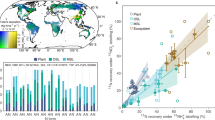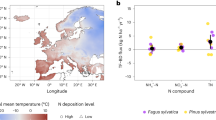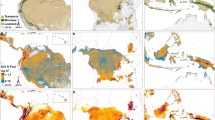Abstract
Tropical forests account for one third of terrestrial primary production and contribute significantly to the land carbon sink1,2. The future of this sink relies critically on forest interactions with nutrient cycles3,4,5. Humid montane tropical forests are often thought to be rich in phosphorus, but to contain low levels of bioavailable nitrogen6. Here, we examine the concentration of dissolved nitrogen compounds and the isotopic composition of nitrate in streams in six well-characterized and phosphorus-rich montane forests7 in Costa Rica, and in 55 montane forests across Central America and the Caribbean, using data collected between 1990 and 2008. We found high levels of nitrate in these streams, indicative of large losses of bioavailable nitrogen from these forests. We detected no trend in the concentration and isotopic signature of nitrate over the measurement period, implying that high levels of export are neither recent nor episodic. An analysis of the oxygen isotopic signature of stream nitrate showed that exports are sourced from the plant–soil system, rather than from atmospheric deposition that bypasses forest biota. Our findings indicate that nitrogen-rich conditions can develop irrespective of phosphorus availability at the ecosystem scale. We suggest that nitrogen availability may not limit plant growth, or its response to increasing atmospheric carbon dioxide levels, in many montane tropical forests.
This is a preview of subscription content, access via your institution
Access options
Subscribe to this journal
Receive 12 print issues and online access
$259.00 per year
only $21.58 per issue
Buy this article
- Purchase on Springer Link
- Instant access to full article PDF
Prices may be subject to local taxes which are calculated during checkout



Similar content being viewed by others
References
Field, C., Behrenfeld, M., Randerson, J. & Falkowski, P. Primary production of the biosphere: Integrating terrestrial and oceanic components. Science 281, 237–240 (1998).
Phillips, O. et al. Changes in the carbon balance of tropical forests: Evidence from long-term plots. Science 282, 439–442 (1998).
Vitousek, P. Nutrient Cycling and Limitation, Hawai’i as a Model System (Princeton Univ. Press, 2004).
Hedin, L. O., Brookshire, E. N. J., Menge, D. N. L. & Barron, A. R. The nitrogen paradox in tropical forest ecosystems. Annu. Rev. Ecol. Evol. Syst. 40, 613–635 (2009).
Barron, A. et al. Molybdenum limitation of asymbiotic nitrogen fixation in tropical forest soils. Nature Geosci. 2, 42–45 (2009).
Tanner, E., Vitousek, P. & Cuevas, E. Experimental investigation of nutrient limitation of forest growth on wet tropical mountains. Ecology 79, 10–22 (1998).
Newbold, J. D., Sweeney, B., Jackson, J. & Kaplan, L. Concentrations and export of solutes from 6 mountain streams in northwestern Costa Rica. J. North Am. Benth. Soc. 14, 21–37 (1995).
Porder, S., Vitousek, P., Chadwick, O., Chamberlain, C. & Hilley, G. Uplift, erosion, and phosphorus limitation in terrestrial ecosystems. Ecosystems 10, 158–170 (2007).
LeBauer, D. & Treseder, K. Nitrogen limitation of net primary productivity in terrestrial ecosystems is globally distributed. Ecology 89, 371–379 (2008).
Templer, P., Silver, W., Pett-Ridge, J., DeAngelis, K. & Firestone, M. Plant and microbial controls on nitrogen retention and loss in a humid tropical forest. Ecology 89, 3030–3040 (2008).
Menge, D. N. L., Pacala, S. W. & Hedin, L. O. Emergence and maintenance of nutrient limitation over multiple timescales in terrestrial ecosystems. Am. Nat. 173, 164–175 (2009).
Hedin, L. O., Vitousek, P. M. & Matson, P. A. Nutrient losses over four million years of tropical forest development. Ecology 84, 2231–2255 (2003).
Neill, C., Deegan, L., Thomas, S. & Cerri, C. Deforestation for pasture alters nitrogen and phosphorus in small Amazonian Streams. Ecol. Appl. 11, 1817–1828 (2001).
Lewis, W., Melack, J., McDowell, W., McClain, M. & Richey, J. Nitrogen yields from undisturbed watersheds in the Americas. Biogeochemistry 46, 149–162 (1999).
Aber, J. et al. Is nitrogen deposition altering the nitrogen status of Northeastern forests? BioScience 53, 375–389 (2003).
Perakis, S. S. & Hedin, L. O. Nitrogen loss from unpolluted South American forests mainly via dissolved organic compounds. Nature 415, 416–419 (2002).
Dentener, F. et al. Nitrogen and sulfur deposition on regional and global scales: A multimodel evaluation. Glob. Biogeochem. Cycles 20, GB4003 (2006).
Goodale, et al. Unusual seasonal patterns and inferred processes of nitrogen retention in forested headwaters of the Upper Susquehanna River. Biogeochemistry 93, 197–218 (2009).
Davidson, E. et al. Recuperation of nitrogen cycling in Amazonian forests following agricultural abandonment. Nature 447, 995–998 (2007).
Sigman, D. et al. Coupled nitrogen and oxygen isotope measurements of nitrate along the eastern North Pacific margin. Glob. Biogeochem. Cycles 19, GB4022 (2005).
Hastings, M., Jarvis, J. & Steig, E. Anthropogenic impacts on nitrogen isotopes of ice-core nitrate. Science 324, 1288–1288 (2009).
Trumbore, S., Chadwick, O. & Amundson, R. Rapid exchange between soil carbon and atmospheric carbon dioxide driven by temperature change. Science 272, 393–396 (1996).
Durka, W., Schulze, E., Gebauer, G. & Voerkelius, S. Effects of forest decline on uptake and leaching of deposited nitrate determined from 15N and 18O measurements. Nature 372, 765–767 (1994).
Barnes, R. T., Raymond, P. A. & Casciotti, K. L. Dual isotope analyses indicate efficient processing of atmospheric nitrate by forested watersheds in the northeastern US. Biogeochemistry 90, 15–27 (2008).
Houlton, B., Sigman, D. & Hedin, L. Isotopic evidence for large gaseous nitrogen losses from tropical rainforests. Proc. Natl. Acad. Sci. USA 103, 8745–8750 (2006).
Reed, S., Cleveland, C. & Townsend, A. Tree species control rates of free-living nitrogen fixation in a tropical rainforest. Ecology 89, 2924–2934 (2008).
Barron, A. R., Purves, D. W. & Hedin, L. O. Facultative nitrogen fixation by canopy legumes in a lowland tropical forest. Oecologia 165, 511–520 (2010).
Sigman, D. et al. A bacterial method for the nitrogen isotopic analysis of nitrate in seawater and freshwater. Anal. Chem. 73, 4145–4153 (2001).
Casciotti, K., Sigman, D., Hastings, M., Bohlke, J. & Hilkert, A. Measurement of the oxygen isotopic composition of nitrate in seawater and freshwater using the denitrifier method. Anal. Chem. 74, 4905–4912 (2002).
Acknowledgements
We thank R. Morales for field assistance in Costa Rica and S. A. Thomas for supporting travel to Trinidad. This work was supported by grants from the A.W. Mellon Foundation, the NSF (DEB-0614116) and NOAA to L.O.H. Financial support for meteorological and chemical data from Estación Maritza came from the NSF (BSR-90078445, DEB 9904047 and DEB 0516516) and from the research endowments of the Stroud Water Research Center. Maritza samples from 1999 to 2001 were provided by L. A. Kaplan.
Author information
Authors and Affiliations
Contributions
E.N.J.B. and L.O.H. conceived of the project, analysed data and wrote the paper. E.N.J.B. conducted field work and isotope analyses. J.D.N., D.M.S. and J.K.J. helped with analysis and writing.
Corresponding author
Ethics declarations
Competing interests
The authors declare no competing financial interests.
Supplementary information
Supplementary Information
Supplementary Information (PDF 1034 kb)
Rights and permissions
About this article
Cite this article
Brookshire, E., Hedin, L., Newbold, J. et al. Sustained losses of bioavailable nitrogen from montane tropical forests. Nature Geosci 5, 123–126 (2012). https://doi.org/10.1038/ngeo1372
Received:
Accepted:
Published:
Issue Date:
DOI: https://doi.org/10.1038/ngeo1372
This article is cited by
-
Andean headwater and piedmont streams are hot spots of carbon dioxide and methane emissions in the Amazon basin
Communications Earth & Environment (2023)
-
Can we see the nitrate from the trees? Long-term linkages between tropical forest productivity and stream nitrogen concentrations
Biogeochemistry (2023)
-
Contrasting Responses of Soil Nematode Trophic Groups to Long-Term Nitrogen Addition
Ecosystems (2023)
-
Understory vegetation altered soil CO2 and N2O emissions and the correlation with plant and soil stoichiometry following N and P addition in Chinese fir plantations
Plant and Soil (2023)
-
Global distribution and climate sensitivity of the tropical montane forest nitrogen cycle
Nature Communications (2022)



